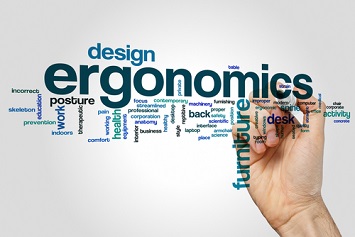When you make purchasing, design, and maintenance decisions, do you consider them from an ergonomic angle? Here are some expert views on the subject along with practical tips you can start implementing today to help those at your facility find the right balance for comfort and productivity.

ibreakstock / Shutterstock.com
A few years ago, we started hearing that “sitting is the new smoking,” an alarming claim about the potential risks of spending hours every day in a chair. While the risks are valid, there is also a great deal more nuance to ergonomics. Facilities managers have the opportunity to make a big impact on the ergonomics within their buildings—know the facts about ergonomic hazards and how they can be influenced through facility design, furniture, training, and awareness.
Standing Up to the Risks
What do hospital employees, retail workers, pharmacists, machine operators, and factory workers have in common? They spend long hours on their feet. A National Institute of Occupational Safety and Health (NIOSH) review of research on the risks showed “ample evidence that prolonged standing at work (primarily in one place) increases risk of low back pain, cardiovascular problems, and pregnancy outcomes.” The Cornell University Ergonomics Web notes that standing requires 20 percent more energy than sitting.
After studying the impact of interventions like floor mats, shoe inserts, adjustable chairs, and sit-stand workstations NIOSH concluded, “dynamic movement appeared to be the best solution for reducing risk of these health problems due to prolonged standing.” Dynamic movement refers to the ability to walk around, or shift from standing to sitting or leaning during the work shift. NIOSH recommends that jobs be designed to allow employees control over their own bodies, permitting them to assume different sit/stand postures and move as they need.
The British website Safe Workers notes that standing for long periods can worsen heart disease in employees who already have the condition. Attitudes can be part of the problem too, with some employers believing that “staff who are standing create a better impression with customers.”
Additional insight on standing comes from the Canadian Center for Occupational Health and Safety (CCOHS), which points to risks including swelling of the legs, varicose veins, and stiffness in the neck and shoulders. Standing motionless reduces the blood supply to the loaded muscles. Insufficient blood flow accelerates fatigue and causes pain in the muscles of the legs, back, and neck—the ones used to keep the body upright.
Prolonged standing also causes blood to pool in the legs and feet and can cause the joints of the spine, hips, knees, and feet to become temporarily immobilized. In terms of productivity standing can affect the quality of tasks that require fine motor skills, focus, and concentration.
Safer Standing by Design
CCOHS concurs with NIOSH that job design can have a significant impact on standing-related discomfort. Workstation layout, tools, and placement of controls, displays, and other equipment will determine the body positions a worker can assume while standing. Lack of flexibility in positioning contributes to health problems. This typically occurs when work is designed without considering the needs and characteristics of the body.
Recommendations for safer standing:
- Make worktables and benches adjustable or, if this is not possible, provide platforms to raise the shorter worker or place pedestals on top of workstations for the taller employee.
- Organize the workspace to provide enough room to move around and change body position, for example by using built-in foot rails or portable footrests, which allow the worker to shift weight from one leg to the other. Elbow supports for precision work can reduce tension in the upper arms and neck.
- Position controls and tools so workers can reach them easily without twisting or bending.
- Provide a seat, where possible, to permit the worker to perform the job either sitting or standing.
- Train employees who stand to always face the object of the work, keep the body close to the work, and avoid overreaching.
- Encourage shoes that do not change the shape of the foot, have a firm grip at the heel, and allow movement of the toes.
- Be mindful of flooring. Hard concrete floors are the worst surfaces for standing for long periods because they do not provide flexibility. Anti-fatigue mats can help, but make sure they’re not too soft.

Peopleimages / iStock / Getty Images Plus / Getty images
Are You Sitting Down for This?
Dr. James A. Levine of the Mayo Clinic links sitting for long periods with health issues including obesity and metabolic syndrome, described as a cluster of conditions including elevated blood pressure and blood sugar, excess fat around the waist, and abnormal cholesterol levels.
“Too much sitting also seems to increase the risk of death from cardiovascular disease and cancer,” adds Levine. Of particular concern is the fact that spending a few hours a week at the gym or doing other types of moderate or vigorous activity “doesn’t seem to significantly offset the risk.”
Physical ills aren’t the only concern. The Association for Psychological Science points to research showing that sitting for more than six hours a day at work may also increase risks of mental health problems like anxiety and depression.
Professor Alan Hedge is one of the country’s foremost experts in ergonomics. Hedge, who leads the prestigious Cornell Human Factors and Ergonomics Laboratory, agrees that too much sitting or standing can be hazardous. “The human body is designed to move, which means if your job involves a lot of standing work you need to sit down and move around. If your work involves a lot of sitting, you need to periodically stand up and move around.”
Hedge underscores the need for balance, adding that anyone who thinks the answer is simply pushing aside the desk chair and standing all day is mistaken. “There are just as many problems associated with standing for a long period of time as there are sitting,” he explains.
In order to determine if postural changes are needed Hedge advises workers to keep a simple sit/stand/move diary. Those who do this often discover that they are sitting for the greater part of the day.
Understanding Biomechanical Changes
Hedge, like other experts in the field, emphasizes that the health issues are a result of biomechanical changes that occur in the body after about an hour of either sitting or standing. The process starts with the enzyme lipoprotein lipase, which directs calories to muscle or to fat. Regular movement directs the calories to muscle, while a sedentary posture sends the calories to fat.
Adds Hedge, “Research shows that if you’ve been sitting all day the level of the enzyme falls by about 90 percent compared to the start of the day.” Unfortunately, a workout after a day of sitting or standing does not undo the damage. His research found that just 34 extra calories consumed per day could lead to a 35-pound weight gain over a 10-year period. Introducing more movement can easily burn those extra daily calories and prevent unhealthy long-term weight gain.
Hedge has derived a formula that recommends a mix of sitting, standing, and moving. He suggests working seated, in a good posture, for 20 minutes, followed by eight minutes of standing, then two minutes of movement such as gentle stretching or walking as a ballpark goal for organizing work. During a 7.5-hour workday (excluding lunch) this would look like five hours of sitting, 16 sit-to-stand changes, two hours of standing, and a half hour of moving.
The formula is not hard and fast, but can serve as a guideline for getting people up and moving. According to Hedge research shows that changing position from sitting to standing many times throughout the day (“frequent postural changes”) helps overcome the negative biomechanical changes.
While sit-stand workstations can be expensive and may not result in long-term increases in standing, organizing work to permit people to change position frequently is not costly, notes Hedge. The precise number of minutes of sitting or moving is not the issue as much as building frequent movement variety into the normal workday. Examples are walking to a printer or water fountain, standing for a meeting, taking the stairs, walking around the work floor, or parking a bit further away from the building each day.

Monkey Business Images / Shutterstock.com
The Plusses of Postural Rotation
Carrie Schmitz agrees with Professor Hedge that movement, or postural rotation, is key to finding balance and good health. But as the senior manager of ergonomics and wellness research for Ergotron, a leading maker of sit-stand workstations, Schmitz is understandably more bullish on the devices. Ergotron is a Minnesota-based company founded in 1982 and dedicated to “improving the human interface with digital displays.”
The company holds more than 70 patents for mounting and mobility products for monitors, notebooks, and other devices. The corporate website explains that “while Ergotron devices are not intended to cure, treat, mitigate, or prevent any disease, they can enhance computing wellness or entertainment excitement, improve workplace productivity, or create business process efficiencies…”
“We live in a chair-biased society where one’s status is reflected to a large extent in whether one works sitting, as in an administrative job, or standing, as assembly line laborers often do,” says Schmitz. She believes this bias can be detected in phrases like “chairman of the board.”
From initial work in the 1980s on “arms” that gave inert CRT computer monitors tilt and movement, Ergotron developed other enhancements to lift and tilt computing equipment. Several years ago Ergotron specialists began to realize that proper placement of computer equipment not only reduced the chance of musculoskeletal disorders, it also could help reduce the metabolic changes described by Professor Hedge and others.
One of the company’s early offerings was a wheeled computer cart that permitted hospital workers to get off their feet and sit, for example, while entering notes into a computer at the patient’s bedside. This led to more generalized sit-stand solutions to help employees sit less and stand more. In several instances Ergotron provided equipment to researchers in the U.S. and abroad to study the effects of giving employees the option to sit or stand.
Schmitz’s list of sitting risks includes back pain and disc degeneration, heart disease, type 2 diabetes, hemorrhoids, muscle degeneration, and others. She says that while the risks are not identical to smoking, the level of danger is the same. “For instance, while smoking can lead to lung cancer, a sedentary lifestyle can cause colon cancer.”
Individuals are often unaware of just how much they sit. To help figure that out, Ergotron has developed a tool on its website www.juststand.org. Ergotron recommends a cycle of sitting for no more than 30 minutes, then standing for no more than 30 minutes to keep muscles activated.
The Good News
Despite the gloomy facts about sitting, Schmitz acknowledges that it doesn’t take much to battle the sedentary lifestyle. It’s a matter of building low-level activity into one’s routine. According to Schmitz modern humans have substituted many of the activities we used to do for survival with bouts of vigorous exercise. She advocates re-inserting some of that activity back into the day, for example by taking the stairs, walking to deliver a message to a colleague rather than emailing, taking stretch breaks, etc.
Schmitz urges employers to get creative about helping workers find ways to combine sitting and standing; these may or may not include a sit-stand workstation. Beyond physical health and comfort, giving workers more autonomy in decisions about their posture can yield positive psychosocial benefits. Employees like to be involved—whether by serving on a safety or ergonomics committee, or by making decisions about how often they stand, sit, and move while performing their jobs.
